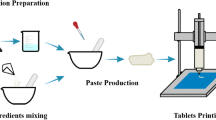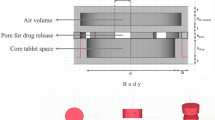Abstract
This study aimed to optimize the size of capsule-shaped 3D-printed devices (CPD) using an experimental design by the response surface methodology to provide a gastroretentive drug delivery system (GRDDS) with optimal floating time. The CPD was fabricated using a fused deposition modeling (FDM) 3D printer. The central composite design was employed for the optimization of the devices. The morphology of the CPD was observed using a digital microscope and scanning electron microscope (SEM). The in vitro floating time and drug release were evaluated using a USP dissolution apparatus II. Appropriate total floating time (TFT) of the devices (more than 3 h) was obtained with the device’s body, cap, and bottom thickness of 1.2, 1.8, and 2.9 mm, respectively. The release kinetics of the drug from the devices fitted well with zero-order kinetics. In conclusion, the optimization of CPD for GRDDS using the experimental design provided the devices with desirable floating time and ideal drug release characteristics.
Graphical abstract






Similar content being viewed by others
References
Goyanes A, Fina F, Martorana A, Sedough D, Gaisford S, Basit AW. Development of modified release 3D printed tablets (printlets) with pharmaceutical excipients using additive manufacturing. Int J Pharm. 2017;527(1-2):21–30. https://doi.org/10.1016/j.ijpharm.2017.05.021.
Chai X, Chai H, Wang X, Yang J, Li J, Zhao Y, et al. Fused deposition modeling (FDM) 3D printed tablets for intragastric floating delivery of domperidone. Sci Rep. 2017;7(1):2829. https://doi.org/10.1038/s41598-017-03097-x.
Goyanes A, Buanz AB, Basit AW, Gaisford S. Fused-filament 3D printing (3DP) for fabrication of tablets. Int J Pharm. 2014;476(1-2):88–92. https://doi.org/10.1016/j.ijpharm.2014.09.044.
Lamichhane S, Bashyal S, Keum T, Noh G, Seo JE, Bastola R, et al. Complex formulations, simple techniques: can 3D printing technology be the midas touch in pharmaceutical industry? Asian J Pharm Sci. 2019;14(5):465–79. https://doi.org/10.1016/j.ajps.2018.11.008.
Economidou SN, Pere CPP, Reid A, Uddin MJ, Windmill JFC, Lamprou DA, et al. 3D printed microneedle patches using stereolithography (SLA) for intradermal insulin delivery. Mater Sci Eng C Mater Biol Appl. 2019;102:743–55. https://doi.org/10.1016/j.msec.2019.04.063.
Ali Z, Türeyen EB, Karpat Y, Çakmakcı M. Fabrication of polymer micro needles for transdermal drug delivery system using DLP based projection stereo-lithography. Procedia CIRP. 2016;42:87–90. https://doi.org/10.1016/j.procir.2016.02.194.
Clark EA, Alexander MR, Irvine DJ, Roberts CJ, Wallace MJ, Sharpe S, et al. 3D printing of tablets using inkjet with UV photoinitiation. Int J Pharm. 2017;529(1-2):523–30. https://doi.org/10.1016/j.ijpharm.2017.06.085.
Charoenying T, Patrojanasophon P, Ngawhirunpat T, Rojanarata T, Akkaramongkolporn P, Opanasopit P. Three-dimensional (3D)-printed devices composed of hydrophilic cap and hydrophobic body for improving buoyancy and gastric retention of domperidone tablets. Eur J Pharm Sci. 2020;155:105555. https://doi.org/10.1016/j.ejps.2020.105555.
Shin S, Kim TH, Jeong SW, Chung SE, Lee DY, Kim DH, et al. Development of a gastroretentive delivery system for acyclovir by 3D printing technology and its in vivo pharmacokinetic evaluation in Beagle dogs. PLoS One. 2019;14(5):e0216875. https://doi.org/10.1371/journal.pone.0216875.
Mandal UK, Chatterjee B, Senjoti FG. Gastro-retentive drug delivery systems and their in vivo success: a recent update. Asian J Pharm Sci. 2016;11(5):575–84. https://doi.org/10.1016/j.ajps.2016.04.007.
Pawar VK, Kansal S, Garg G, Awasthi R, Singodia D, Kulkarni GT. Gastroretentive dosage forms: a review with special emphasis on floating drug delivery systems. Drug Deliv. 2011;18(2):97–110. https://doi.org/10.3109/10717544.2010.520354.
Nayak A, Malakar J, Sen K. Gastroretentive drug delivery technologies: current approaches and future potential. J Pharm Educ Res. 2010;1(2):1–12.
Lopes CM, Bettencourt C, Rossi A, Buttini F, Barata P. Overview on gastroretentive drug delivery systems for improving drug bioavailability. Int J Pharm. 2016;510(1):144–58. https://doi.org/10.1016/j.ijpharm.2016.05.016.
Iglesias N, Galbis E, Romero-Azogil L, Benito E, Lucas R, Garcia-Martin MG, et al. In-depth study into polymeric materials in low-density gastroretentive formulations. Pharmaceutics. 2020;12(7). https://doi.org/10.3390/pharmaceutics12070636.
Li Q, Guan X, Cui M, Zhu Z, Chen K, Wen H, et al. Preparation and investigation of novel gastro-floating tablets with 3D extrusion-based printing. Int J Pharm. 2018;535(1-2):325–32. https://doi.org/10.1016/j.ijpharm.2017.10.037.
Fu J, Yin H, Yu X, Xie C, Jiang H, Jin Y, et al. Combination of 3D printing technologies and compressed tablets for preparation of riboflavin floating tablet-in-device (TiD) systems. Int J Pharm. 2018;549(1-2):370–9. https://doi.org/10.1016/j.ijpharm.2018.08.011.
Qi X, Ren Y, Wang X. New advances in the biodegradation of poly(lactic) acid. Int Biodeterior Biodegradation. 2017;117:215–23. https://doi.org/10.1016/j.ibiod.2017.01.010.
Song JH, Murphy RJ, Narayan R, Davies GB. Biodegradable and compostable alternatives to conventional plastics. Philos Trans R Soc Lond Ser B Biol Sci. 2009;364(1526):2127–39. https://doi.org/10.1098/rstb.2008.0289.
Xu L, Crawford K, Gorman CB. Effects of temperature and pH on the degradation of poly(lactic acid) brushes. Macromolecules. 2011;44(12):4777–82. https://doi.org/10.1021/ma2000948.
Huanbutta K, Sangnim T. Design and development of zero-order drug release gastroretentive floating tablets fabricated by 3D printing technology. J Drug Deliv Sci Technol. 2019;52:831–7. https://doi.org/10.1016/j.jddst.2019.06.004.
Aggarwal A, Bhatt M. Commonly used gastrointestinal drugs. Handb Clin Neurol. 2014;120:633–43. https://doi.org/10.1016/B978-0-7020-4087-0.00043-7.
Reddymasu SC, Soykan I, McCallum RW. Domperidone: review of pharmacology and clinical applications in gastroenterology. Am J Gastroenterol. 2007;102(9):2036–45. https://doi.org/10.1111/j.1572-0241.2007.01255.x.
Paulo F, Santos L. Design of experiments for microencapsulation applications: a review. Mater Sci Eng C Mater Biol Appl. 2017;77:1327–40. https://doi.org/10.1016/j.msec.2017.03.219.
Bezerra MA, Santelli RE, Oliveira EP, Villar LS, Escaleira LA. Response surface methodology (RSM) as a tool for optimization in analytical chemistry. Talanta. 2008;76(5):965–77. https://doi.org/10.1016/j.talanta.2008.05.019.
Pound J. British Pharmacopoeia Health Ministers of the United Kingdom; 2019.
Charoenying T, Patrojanasophon P, Ngawhirunpat T, Rojanarata T, Akkaramongkolporn P, Opanasopit P. Effects of thermal crosslinking on the properties and release profiles of three-dimensional (3D)-printed poly vinyl alcohol (PVA) tablets. Key Eng Mater. 2020;859:258–64. https://doi.org/10.4028/www.scientific.net/KEM.859.258.
Charoenying T, Patrojanasophon P, Ngawhirunpat T, Rojanarata T, Akkaramongkolporn P, Opanasopit P. Fabrication of floating capsule-in-3D-printed devices as gastro-retentive delivery systems of amoxicillin. J Drug Deliv Sci Technol. 2020;55:101393. https://doi.org/10.1016/j.jddst.2019.101393.
Tagami T, Fukushige K, Ogawa E, Hayashi N, Ozeki T. 3D printing factors important for the fabrication of polyvinylalcohol filament-based tablets. Biol Pharm Bull. 2017;40:357–64. https://doi.org/10.1248/bpb.b16-00878.
Goyanes A, Buanz AB, Hatton GB, Gaisford S, Basit AW. 3D printing of modified-release aminosalicylate (4-ASA and 5-ASA) tablets. Eur J Pharm Biopharm. 2015;89:157–62. https://doi.org/10.1016/j.ejpb.2014.12.003.
Singpanna K, Charoenying T, Patrojanasophon P, Rojanarata T, Sukma M, Opanasopit P. Fabrication of a floating device of domperidone tablets using 3D-printing technologies. Key Eng Mater. 2020;859:289–94. https://doi.org/10.4028/www.scientific.net/KEM.859.289.
Acknowledgements
The authors gratefully thank the Commission of Higher Education (Thailand), the Thailand Research Funds through the Royal Golden Jubilee Ph.D. Program (Grant No.PHD/0022/2560), and the Research Team Promotion Grant (RTA6180003) for their financial support.
Author information
Authors and Affiliations
Corresponding author
Additional information
Publisher’s Note
Springer Nature remains neutral with regard to jurisdictional claims in published maps and institutional affiliations.
Rights and permissions
About this article
Cite this article
Charoenying, T., Patrojanasophon, P., Ngawhirunpat, T. et al. Design and Optimization of 3D-Printed Gastroretentive Floating Devices by Central Composite Design. AAPS PharmSciTech 22, 197 (2021). https://doi.org/10.1208/s12249-021-02053-3
Received:
Accepted:
Published:
DOI: https://doi.org/10.1208/s12249-021-02053-3




